Yuki-onna: Japan’s Enchanting Spirit of Snow and Silence
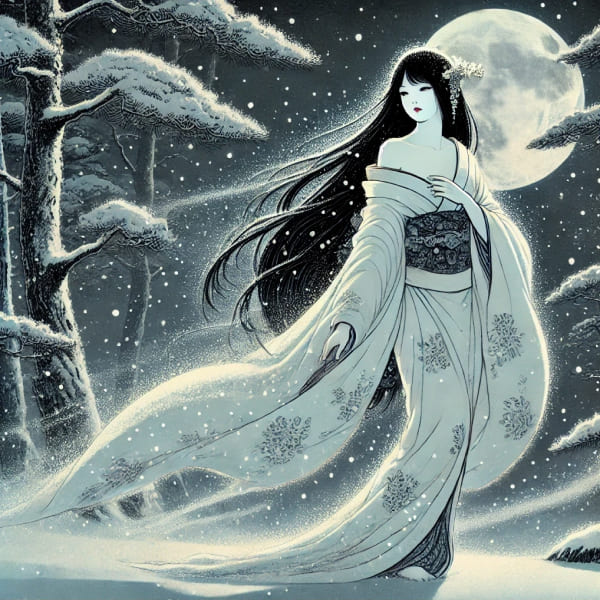
Contents
Have you ever walked along a snowy path at night, when the world falls so silent that it feels as if someone—unseen—is beside you?
In Japan, that presence has a name: Yuki-onna, the Snow Woman.
She is one of the country’s most famous yokai—a breathtaking figure in a white kimono, with moon-pale skin and hair as dark as ink on snow.
But who exactly is she?
What stories surround this mysterious figure?
Whether you’re new to Japanese folklore or already a fan, let’s meet Yuki-onna together. We’ll explore the origins of her legend, uncover why her image is both beautiful and dangerous, and see how her stories continue to inspire culture and imagination today.
The Enigmatic Lady of Snow
To start, let’s explore the question: who is Yuki-onna, the Snow Woman?
Her name means simply “Snow Woman” (雪女), and she is one of the most famous spirits in Japanese folklore. Tales of her are especially common in the snowy regions of northern Japan—places like the Tohoku area, where winter storms can blanket the mountains for months.
Unlike many yokai, Yuki-onna isn’t just a trickster or a wandering ghost. She is tied directly to nature itself—the snow, the storm, and the silence of winter nights. For people living in harsh mountain villages, her presence in folklore reflected both the beauty and the danger of the season.
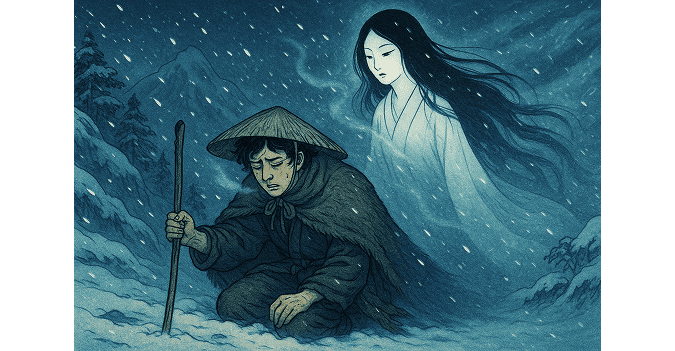
Sometimes she is described as a merciless spirit, freezing unlucky travelers where they stand. Other times, she appears as a mysterious guardian, sparing the lost or rewarding kindness.
It is this mix of life-giving beauty and deadly peril that has made Yuki-onna unforgettable for centuries—and why she still fascinates people today.
Quick Profile: Yuki-onna
Let’s take a moment to summarize what makes Yuki-onna so unique.
| Aspect | Details |
|---|---|
| Name | Yuki-onna (雪女) — “Snow Woman” |
| Type | Yokai / Spirit |
| Appearance | White kimono, moon-pale skin, long black hair |
| Region | Snowy northern Japan, especially the Tohoku area |
| Abilities | Freezing breath, life-draining touch, vanishing into snowstorms |
| Nature | Sometimes merciless, sometimes protective |
| Symbolism | The beauty and danger of winter, awe of nature’s power |
Origins and Folklore
Where did the legend of Yuki-onna come from—and why do her stories differ so much across Japan?
In this section, let’s explore when the legend of Yuki-onna first appeared in history and the main patterns found in her stories across Japan.
Origins — When the Snow Woman Was First Seen
The story of Yuki-onna dates back to Japan’s Muromachi period (14th–16th century).
One of the earliest records appears in Sogi Shokoku Monogatari, where a monk describes encountering a mysterious snow woman—beautiful, pale, and silent.
This suggests that by this time, the tale was already well-known in Japan’s snow country.
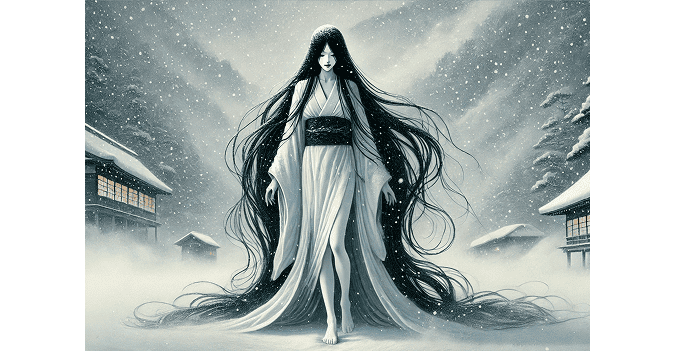
Folklore and Regional Tales — The Many Faces of Yuki-onna
Across Japan, the legend of Yuki-onna has taken many different shapes. Despite their differences, most versions share a few familiar themes that reveal how people have long viewed the beauty and danger of winter.
Let’s look at four of the most common ways Yuki-onna appears in folklore:
The Deathly Beauty:
Dressed in a white kimono—the same color used for funeral robes in Japan—she breathes out a freezing wind that turns travelers to ice.
Her beauty is stunning, but it hides the chill of death itself.
The Mysterious Bride:
In many tales, Yuki-onna appears as a beautiful woman who marries a man she meets by chance. But her secret cannot last—when spring arrives, she vanishes with the snow, leaving behind only a trace of frost or a single shard of ice.
The Gentle Guardian:
Not all stories make her a killer.
In some, she protects children from blizzards or guides lost travelers to safety, showing mercy to those who treat nature with respect.
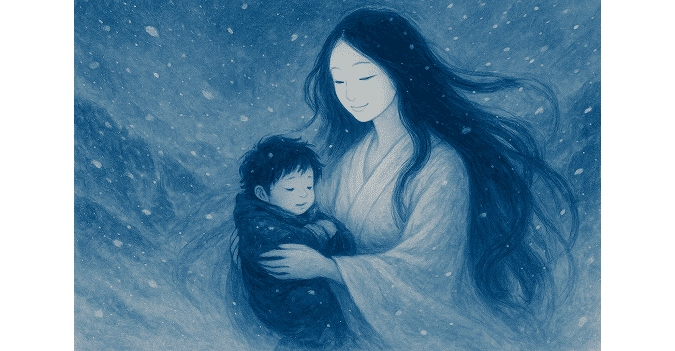
The Fearsome Spirit:
In darker legends, Yuki-onna is a vengeful ghost who drains human life, steals warmth from the living, or lures the lost into the depths of snow-covered mountains.
Her name and appearance may stay the same, but her character shifts with the landscape and beliefs of each region.
To some, she is a warning against nature’s cruelty; to others, a symbol of its haunting beauty.
A Living Tradition
All these tales—whether she appears as a ghost, a lover, or a guardian—show that Yuki-onna is not a single being, but a spirit that changes shape with the land, the storyteller, and the time.
It is this very mystery and flexibility that make her legend so captivating.
By taking many forms, she reflects the different ways people across Japan have understood winter itself—as both a threat to life and a source of quiet beauty.
Her many faces remind us that beauty and fear, warmth and cold, life and death are never far apart—just like the falling snow that melts the moment it touches the earth.
Appearance and Characteristics
Now, let’s take a closer look at Yuki-onna’s appearance.
What does she look like in the stories, and what makes her so unforgettable?
Stories describe Yuki-onna as a woman of breathtaking, almost unearthly beauty.
She moves with a weightless grace, often blending with the falling snow—as if she were part of the storm itself.
Though her appearance changes slightly from region to region, most tales share a few familiar traits.
Common Traits of Yuki-onna
Here’s a simple table summarizing Yuki-onna’s appearance and traits.

| Feature | Description |
|---|---|
| Pale, translucent skin | Said to glow softly, like snow under moonlight. |
| Long dark hair | Flows freely behind her, a striking contrast against the white snow. |
| Shimmering eyes | Calm yet piercing, reflecting the cold beauty of winter nights. |
| Unnatural height | In some stories she appears tall and elegant, in others small and delicate, like a child. |
| Icy breath | Capable of chilling the air or freezing a person instantly. |
| Sudden cold | The temperature drops before she appears, and the air grows still. |
| Vanishing into the snow | She disappears without a trace, melting back into the blizzard. |
These traits together make Yuki-onna both mesmerizing and unsettling—a living vision of winter’s fragile beauty and silent power.
Famous Story: Lafcadio Hearn’s Kwaidan Version
Earlier, we looked at the different versions of Yuki-onna’s legend across Japan. Among them, there is one story that stands out as the most famous of all.
It appears in Kwaidan (1904), a collection of Japanese ghost tales written by Lafcadio Hearn, the man who introduced many of Japan’s mysteries to the world.
This version became the best-known retelling outside Japan, capturing both the eerie beauty and the quiet sadness of the Snow Woman.
Now, let’s step into the snow and hear the story of Yuki-onna as Hearn told it.
The Tale
One winter night long ago, a young woodcutter named Minokichi and his older companion were caught in a fierce snowstorm.
They found shelter in a small hut, but as they slept, the door slid open—and a woman in a flowing white kimono stepped inside. Her face was pale and beautiful beyond mortal comparison.
Without a word, she leaned over the older man and breathed softly upon him. Frost formed on his skin, and in an instant, his life was gone.
When she turned to Minokichi, she looked into his eyes and whispered:
I will spare you—but only if you never tell anyone what you have seen tonight.
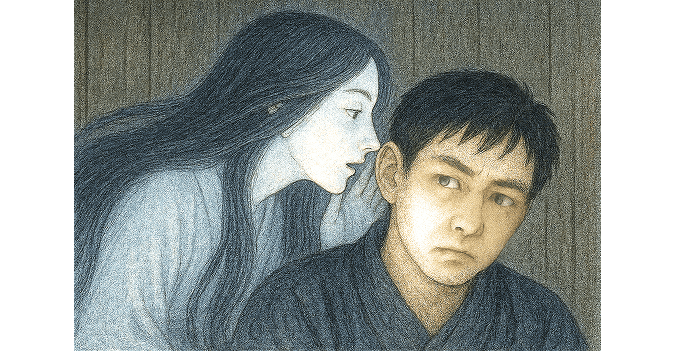
Years passed. Minokichi married a gentle and beautiful woman named O-Yuki, and together they had children.
But one night, as they sat by the hearth, he recalled that strange night in the storm and spoke of it aloud.
As his words fell into the quiet air, O-Yuki’s expression changed.
That was me,
she said softly.
I warned you never to tell.
Her form began to fade, like mist under the morning sun.
In moments, she was gone—vanished into the snow, leaving her husband and children behind.

Why This Story Endures
How did you find the story of Yuki-onna?
Hearn’s Yuki-onna is not cruel, but deeply tragic.
She is more than a ghost—she is a spirit bound by emotion, a woman torn between love and her supernatural nature.
This blend of gentleness and danger, of love and loss, is what makes her story endure across generations.
Even today, Hearn’s version remains the image most people outside Japan imagine when they hear the name Yuki-onna.
Through his storytelling, the Snow Woman transcended folklore and became part of world literature—forever drifting in the snow between life and legend.
Unique Legends of Yuki-onna
We’ve now seen the most famous version of Yuki-onna through Hearn’s story. But beyond that well-known tale, there are also unique local legends about the Snow Woman that differ from the main patterns we explored earlier.
Across Japan, these regional stories add new shades to her character.
Let’s take a look at a few of these lesser-known but captivating, versions from traditional folklore.
The Snow Child Trap
On a blizzard night, Yuki-onna appears holding a child (yuki-ko, or “snow child”) and asks travelers to carry it for her.
At first, the baby feels light—but with each step, it grows heavier and heavier until the victim collapses under its weight, buried in the snow.
Those who refuse her request meet an equally chilling fate, thrown into a frozen ravine.
Some folklorists interpret this as the spirit of a woman who died in childbirth, wandering in search of her lost child.
The Moon Princess
In another tale, Yuki-onna was once a princess from the moon who came down to Earth out of curiosity.
Unable to return, she roams the snowy mountains under moonlight, her beauty untouched by time or warmth.
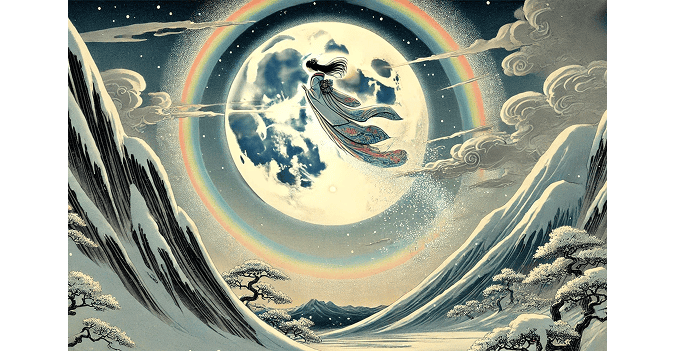
This version connects her to Japan’s long tradition of heavenly maiden legends (tennyo densetsu), where celestial women briefly visit the human world before vanishing again.
The New Year’s Visitor
Some regions say Yuki-onna appears only during the New Year season—from December 30th to the first full moon of January.
She travels with ghostly children, bringing snow wherever she goes.
In some tales, she blesses families who treat her kindly; in others, she leaves behind gold or silver snowflakes as gifts before disappearing.
These stories link her to the Toshigami, the New Year deity who visits homes to bring prosperity, hinting that Yuki-onna may once have been viewed as a sacred winter spirit rather than a ghost.
A Spirit with Many Faces
These regional legends suggest that Yuki-onna has continually evolved—her stories reshaped and reimagined as they intertwined with local traditions and beliefs.
Rooted in snow and winter, she reflects how people across Japan have blended their understanding of life, nature, and mystery into something entirely their own.
Depending on the storyteller and the snow, she can appear cruel or kind, sacred or sorrowful—a spirit forever changing, yet always unmistakably herself.
The Spirit and Aesthetics of Yuki-onna
We’ve seen Yuki-onna as a spirit who embodies the snow and the winter itself. But when we look at her legend through the lens of the Japanese way of finding harmony between humanity and nature, a new kind of fascination emerges.
In this section, let’s explore how the story of Yuki-onna reveals both the aesthetics and the spiritual wisdom that continue to shape Japan’s understanding of nature and life.
Mono no Aware — The Beauty of Impermanence
As you know, snow is destined to melt away with the passing of time.
Its fleeting beauty—the way a pure white landscape fades from sight—mirrors the stories of Yuki-onna, who appears suddenly and disappears when her time has come.
Her beauty takes one’s breath away, yet it cannot last.
Like a snowflake that melts the moment it touches the ground, she reminds us that every beautiful moment already carries the seed of its own end—a truth both sorrowful and serene.
In old Japan, this quiet awareness of beauty and loss was called mono no aware—the gentle sorrow that comes from recognizing the impermanence of all things.
In many ways, Yuki-onna herself becomes the embodiment of that feeling, a living expression of this timeless idea.
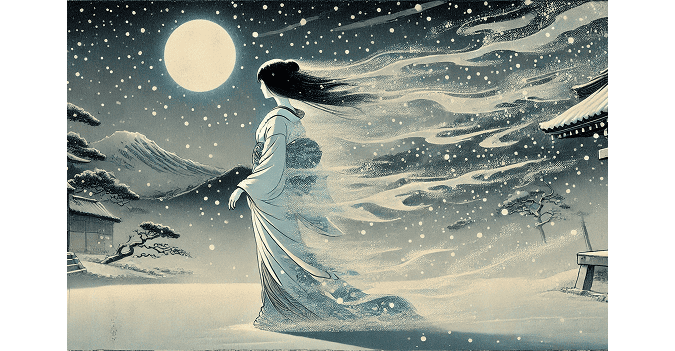
Yugen — The Mystery Beyond Words
There is a mysterious allure in the presence of Yuki-onna—a quiet, almost sacred beauty that draws us in.
It is the kind of beauty that touches the heart rather than the mind, one that cannot be fully explained in words but only felt in silence.
In old Japan, this deep and unspoken sense of elegance was called yugen—an aesthetic that values subtlety, grace, and the power of what remains unseen.
Yuki-onna’s cold yet captivating beauty becomes the very embodiment of this idea.
Through her stillness and her silence, she expresses a beauty that transcends language—a beauty that lingers like a whisper in the snow—the timeless beauty of yugen itself.
Harmony with Nature
Though Yuki-onna takes the form of a woman, she is not separate from nature—she is nature itself.
Her stories speak to us of how people and the natural world are deeply connected, their lives moving in rhythm with the turning of the seasons.
Even her cruelty belongs to that natural cycle.
Winter must be feared for its harshness, yet respected for its beauty and necessity.
Through Yuki-onna, Japanese folklore whispers a timeless lesson: that we are part of the natural world, not its masters.
Her presence continues to remind us of the quiet power of winter—the cold that sustains life as much as it threatens it.
To live in harmony with nature, showing respect for its balance and grace, is part of the enduring wisdom her story carries through the generations.
In this way, the stories of Yuki-onna weave together Japan’s ancient sense of beauty and the quiet lessons that still echo today.
They do more than personify winter or snow—they transform nature into poetry, turning cold and silence into a tale that speaks gently to the heart.
What is beautiful is not only Yuki-onna herself, but the story that carries her name—a story filled with grace, mystery, and the fragile beauty of falling snow, lingering softly, like a memory that never fades.
Snow Woman in Modern Culture
Once feared as a spirit of winter, Yuki-onna has been reimagined in new and fascinating ways within modern culture.
Today, her legend lives on through anime, film, and literature.
Let’s take a look at some of the ways Yuki-onna appears in today’s stories.
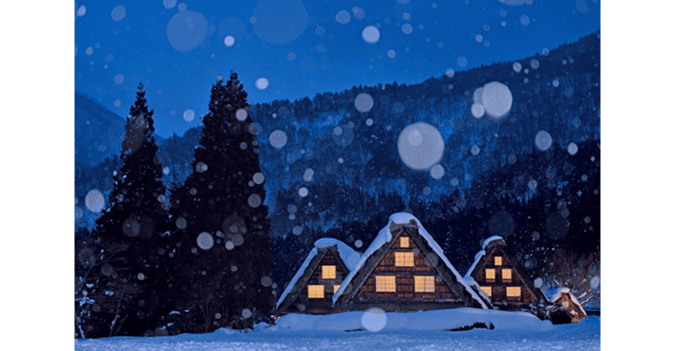
In Anime, Manga, and Games
Many modern creators have reimagined Yuki-onna across different forms of Japanese media.
Here are some of the most well-known examples:
-
Yuki-onna Aoi — Anime & Manga: GeGeGe no Kitaro
A charming yet powerful yokai who bridges the gap between comedy and the supernatural. -
Yukina — Anime: Yu Yu Hakusho
A gentle snow woman driven by love and loyalty, offering a tender reinterpretation of the legend. -
Snow — Video Game Series: Final Fantasy
A reimagined figure of icy strength and mystical grace, inspired by the snow woman’s ethereal beauty. -
Yuki-onna — Game & Anime: Yo-kai Watch
A friendly, childlike version who makes the legend accessible and endearing to younger audiences.
From characters that honor the traditional spirit of Yuki-onna to those with a more playful and modern charm, these works show how her legend continues to evolve—adapting gracefully to each new generation while keeping her timeless allure.
Beyond Japan
Lafcadio Hearn’s Kwaidan (1904) was later adapted into the acclaimed 1964 film of the same name.
In this cinematic version, Yuki-onna’s haunting beauty was introduced to international audiences, earning an Academy Award nomination and inspiring a new generation of storytellers around the world.
Modern Interpretations
In today’s retellings, Yuki-onna is often seen not as a monster, but as a symbol of emotion and solitude—a figure of both beauty and melancholy.
Whether protecting snowy villages or mourning her eternal solitude, she continues to embody the same silent grace and fragile beauty that have defined her for centuries.
Conclusion — The Allure of the Snow Woman
From the snowy legends of old Japan to her many appearances in modern stories, Yuki-onna remains one of the most captivating figures in Japanese folklore.
She is both beautiful and fearsome, gentle and deadly—a spirit who reminds us of the power and mystery of nature.

Through her tales, we see how Japan finds beauty in impermanence, grace in silence, and harmony within nature’s strength. She is the heart of winter itself—cold yet beautiful, fleeting yet unforgettable.
And even today, on a quiet night of falling snow, one might still imagine a woman in white watching from the storm—her eyes shining like frozen moonlight, her presence as timeless as the winter wind.